Vibrational Encounters, Araluen Gallery, Mparntwe-Alice Springs
- 2025
Pip McManus’s Saw Points exhibition at Araluen Gallery
Rod Moss’s Moon Havoc exhibition at Araluen Gallery
Luiz Gabriel Gubeissi & Miriam Nicholls’ dance and music performance Frequencies & Movements performed in the Gallery in response to the work.
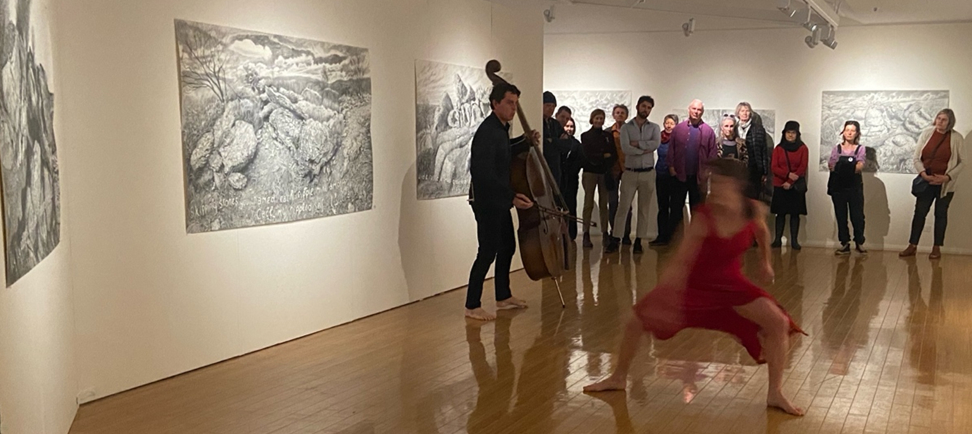
Luiz Gabriel Gubeissi & Miriam Nicholls perform with Rod Moss’s Moon Havoc artworks. Image: Wendy Cowan, 2025
When in the presence of art, I look and listen for portals into other worlds, other ways of being, other ways of relating to difference. At the Araluen Gallery, Mparntwe-Alice Springs, two skilfully curated exhibitions – Pip McManus’s Saw Points and Rod Moss’s Moon Havoc – open a holy ground of care where socio-political and ecological concerns are acknowledged and felt.
Each artwork draws detailed attention into ways humans are literally formed-with light, rocks, migratory birds, buffel grass, and ancient texts. Rod Moss’s large-scale graphite drawings of rocks, skies, burnt branches, sand and textured grasses trace the marks of relationality with inanimate entities, generated through his longstanding friendships with Arrernte custodians pointing the way. Pip McManus reworks mediums and materials that migrate and connect time and place as continuous.
Both artists show us that history is all around us, in the wreck of cargo boats along the Yartapuulti-Port Adelaide shipping routes, in the looting of holy sites, in the care and concern for Arrernte Country as the climate changes. Their art is the embodied labour of attention of picking up, sanding back, re-walking, turning over, listening, and responding to form: its political weight, its revelations, its shadows, its transparencies.
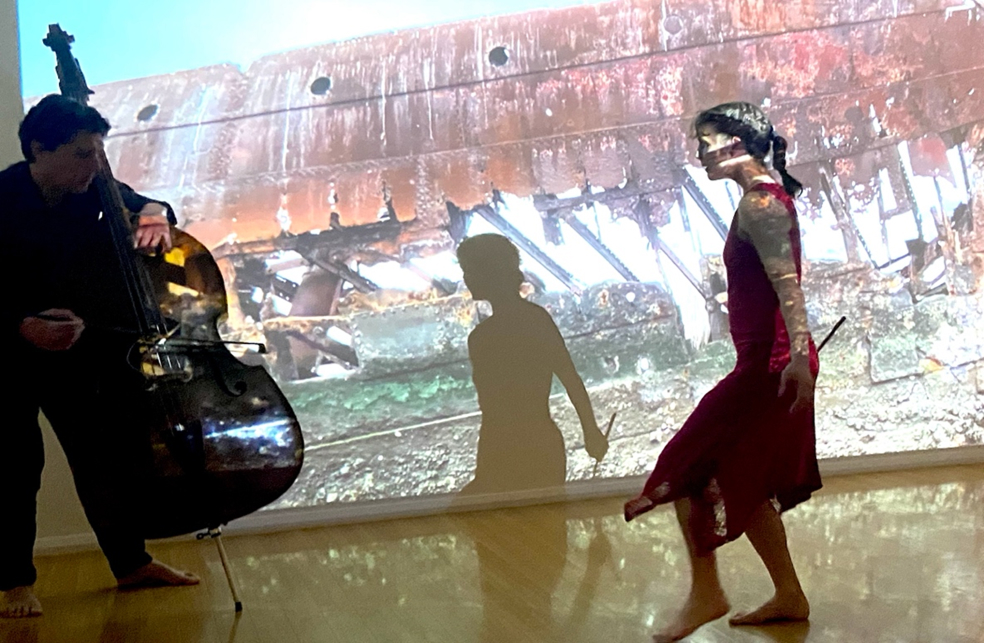
Dancer Miriam Nicholls and musician Luiz Gabriel Gubeissi in front of Pip McManus’s Place of sleep, 2024, single-channel video. Image: Wendy Cowan, 2025
At the exhibition’s opening and closing ceremonies, Luiz Gabriel Gubeissi and Miriam Nicholls performed an improvised dance and music sequence that further opened up gestural experiences within this finely tuned work. Gubeissi and Nicholls connected artworks through their call-and-response sounds and movements. The shrill sound of a clay pipe played by Gubeissi alerted me to the frequencies of this place.
The musician, dancer, and the artists use their whole bodies, their whole intellect to feel their way into ideas and conundrums. In this shared gallery space, they listen deeply to one another – not claiming something: offering something. What is being offered is an attunement-with the world: bodies (not just human) as recorders and creators of deeply felt vibrational encounters in the midst of ecocide, war and oppression. On this day, in this space, we were involved in social listening-with the vibrations of air, sound, and ideas that cut the world anew.
To best illustrate the themes and ideas explored in these joint exhibitions, let us focus on two specific artworks, an installation entitled, Lamentations by McManus and a large-scale work, Call Me, I Will Arise, 2022 by Moss.
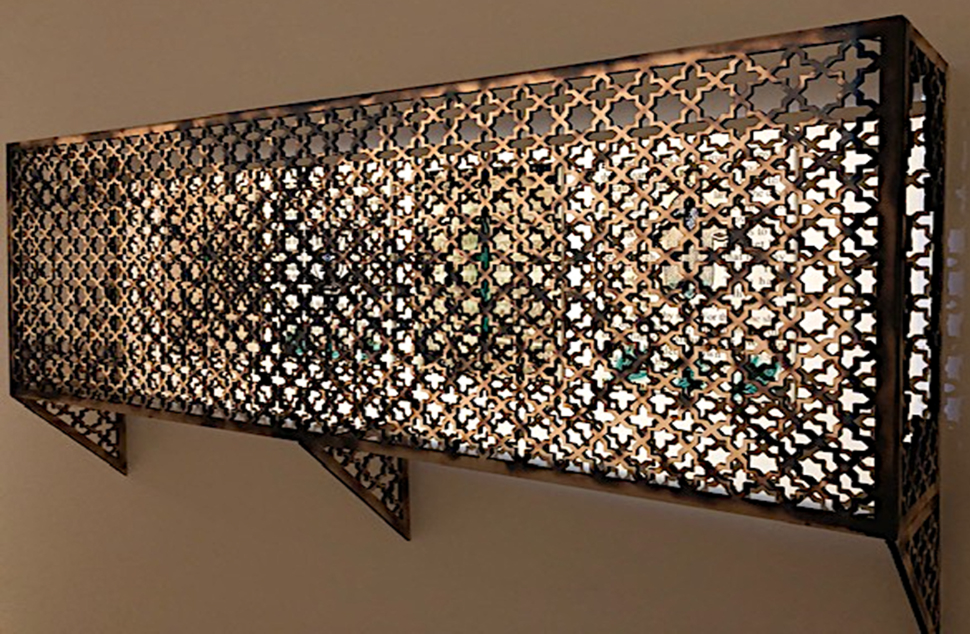
Pip McManus, Lamentations, 2025, oxide printed ceramic tablets MDF laser cut and torched. Image: Wendy Cowan, 2025
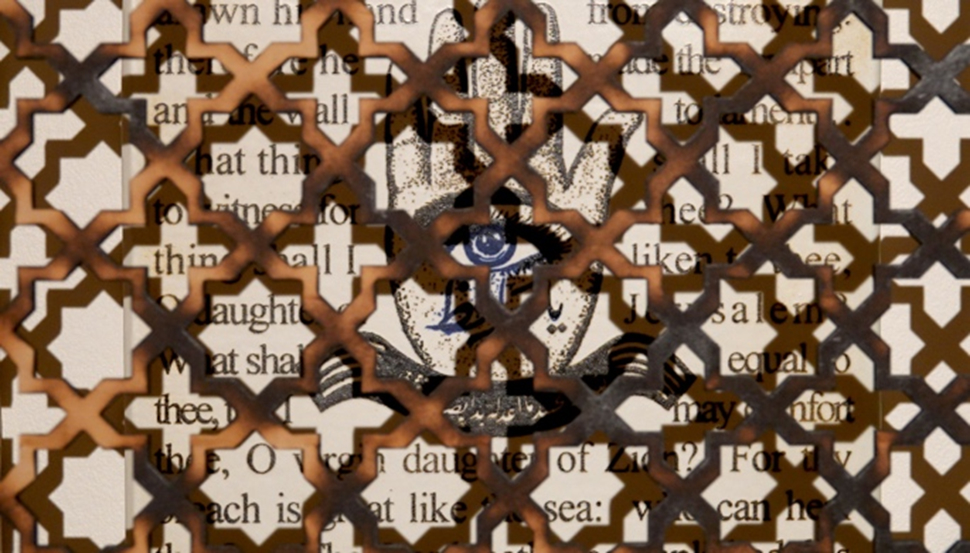
Pip McManus, Lamentations (detail), 2025, oxide printed ceramic tablets MDF laser cut and torched. Image courtesy the artist.
Lamentations is a box-like or an imprisoning latticework that creates a shadowed layering of Islamic patterns on biblical texts, symbols and a Byzantine mosaic map that’s been printed and pressed on a series of clay tablets. The shadows of the latticed enclosure make it difficult to read the tablet’s contents.
Lamentations was first created in 2001 after Pip and her Jewish partner travelled to the Middle East in December 1994, when the first steps towards Palestinian autonomy became visible. A few months later the Oslo II Accord was signed by PLO Chairman Yasser Arafat and Israeli Prime Minister Yitzhak Rabin, and witnessed by US President Bill Clinton as well as by representatives of Norway, Russia, Egypt, Jordan and the European Union.
Looking closely through the protective screen, I make out fragmented texts from the Hebrew Bible’s Book of Lamentations and Habakkuk (the eighth book of the Twelve Minor Prophets). An eye stares back. The text from Habakkuk 2:8-12 reads:
Because you have plundered many nations, the peoples who are left will plunder you.
For you have shed human blood; you have destroyed lands and cities and everyone in them.
Woe to him who builds his house by unjust gain, setting his nest on high to escape the clutches of ruin!
An eye stares back from the palm of a working hand – the ability to see and do things in the world. Here deeds are witnessed, they carry moral weight. In the context of the historical ‘now’ these texts raise vital questions – woe to who, “who builds their house by unjust gain”? Whose nest is set on high and at what cost?
On my way home I witness graffiti text on a tall security fence which reads, “Gaza will haunt us for years to come”.
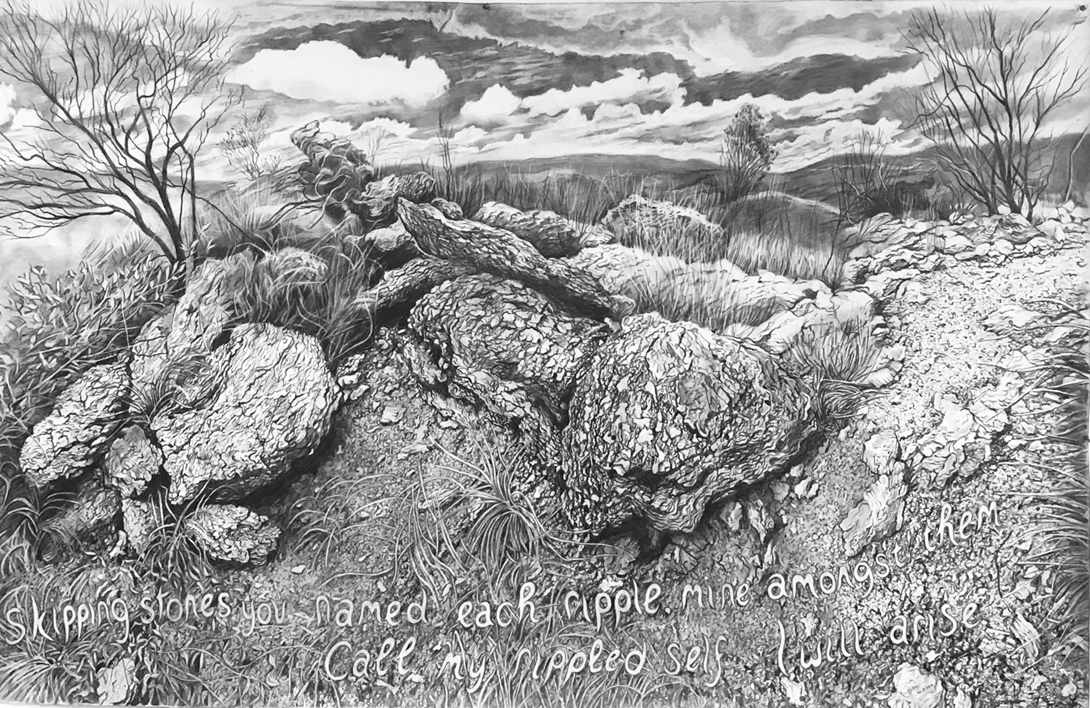
Rod Moss, Call Me, I Will Arise, 2022, graphite on Waterford paper. Image courtesy of the artist.
Back in the gallery, the musician Luiz Gabriel Gubeissi takes up a double bass surrounded by Moss’s large graphite works on paper; scenes drawn from Country close to his Mparntwe Alice Springs home and heart. This is the Country he walked, hunted and camped on with his own and the Whitegate community families, as shown in his earlier, more figurative work.
The work in Moon Havoc is Country up close. I am drawn to a piece entitled Call Me, I Will Arise, 2022. In my mind’s eye I see Moss walking Country, paying attention to shape and form until ‘something’ speaks to him. This is the moment that brings a material relationship into existence – the caress of rocks, the relentless spread of buffel grass, burnt mulga branches, poetic mediations, a horizon line both intimate and infinite. Here, Country is not an inert backdrop or an embellishment to the act of walking, listening, drawing; rather, an inanimate relationality that creates the artist as much as the artist creates the work.
McManus, Moss Gubeissi and Nicholls are all attuned to this reciprocity. Their work and careers are longstanding and prophetic, opening portals into ways of living – and dying – with troubled times and places.
Wendy Cowan was born in Ireland during the Troubles – the colloquial name for the Civil War between Ireland and Britian, lasting approximately 30 years from the mid-1960s to 1998’s Good Friday Agreement. Wendy is a founding member of Stick Mob Studio, a collective of intra-cultural storytellers based on Arrernte Country, Central Australia. Her community-led art work has been exhibited widely and is held in collections in Ireland and Australia.